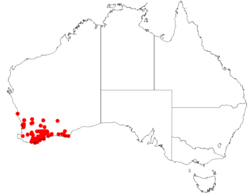Biology:Calectasia grandiflora
| Blue tinsel lily | |
|---|---|

| |
| C. grandiflora at Mount Barker. | |
| Scientific classification Error creating thumbnail: Unable to save thumbnail to destination
| |
| Kingdom: | Plantae |
| Clade: | Tracheophytes |
| Clade: | Angiosperms |
| Clade: | Monocots |
| Clade: | Commelinids |
| Order: | Arecales |
| Family: | Dasypogonaceae |
| Genus: | Calectasia |
| Species: | C. grandiflora
|
| Binomial name | |
| Calectasia grandiflora L.Preiss
| |

| |
| Occurrence data from AVH | |
Calectasia grandiflora, commonly known as the blue tinsel lily, is a plant in the family Dasypogonaceae growing as a perennial herb endemic to the south-west of Western Australia. It flowers in spring.
Description
Calectasia grandiflora is a rhizomatous perennial herb growing to a height of about 60 cm (24 in). The stems have many side branches and bear leaves 5.2–16.5 x 0.4–1.2 mm. The six petals are blue but turn red as they age; the central anthers are yellow and do not change colour as they age, unlike those of some other Calectasia species.[1] Flowers appear from June to October (Winter and Spring) overall,[2] though earlier in Perth than in the wheatbelt and Stirling Ranges.[1]
Taxonomy and naming
Calectasia grandiflora is one of eleven species in the genus Calectasia. It was first described by Ludwig Preiss in Plantae Preissianae in 1846.[3] The specific epithet (grandiflorum) is from the Latin grandis = great and floris = flower referring to the flowers that are relatively large compared to those of the similar C. narragara.[1] It is commonly called the blue tinsel lily.[4] "Large-flowered tinsel lily" has been proposed as an alternate common name to distinguish it from other members of the genus.[1]
Distribution and habitat
Blue tinsel lily grows on sand, sandy clay, gravel, laterite and granite in swampy areas and on rock outcrops, flats, slopes and ridges.[5] It is endemic to the south-western corner of Western Australia, occurring in the Avon Wheatbelt, Esperance, Geraldton Sandplains, Jarrah Forest, Mallee, Swan Coastal Plain and Warren biogeographic regions.[2]
Conservation status
Calectasia grandiflora is not threatened at present.[5]
References
- ↑ 1.0 1.1 1.2 1.3 Barrett, Russell L.; Dixon, Kingsley W. (8 January 2001). "A revision of the genus Calectasia (Calectasiaceae) with eight new species described from south-west Western Australia". Nuytsia 13 (3): 426–427. https://www.biodiversitylibrary.org/item/225810#page/22/mode/1up. Retrieved 10 October 2020.
- ↑ 2.0 2.1 Paczkowska, Grazyna; Chapman, Alex R. (2000). The Western Australian flora : a descriptive catalogue. Perth: Wildflower Society of Western Australia. p. 58. ISBN 0646402439.
- ↑ Preiss, Ludwig (1846). "Calectasieae". Plantae Preissianae 2: 53. https://www.biodiversitylibrary.org/page/499094#page/57/mode/1up. Retrieved 18 February 2015.
- ↑ "Calectasia grandiflora". APNI. https://biodiversity.org.au/boa/instance/apni/518695. Retrieved 11 August 2015.
- ↑ 5.0 5.1 Spooner, Amanda. "Florabase: The Western Australia Flora - Calectasia grandiflora". https://florabase.dpaw.wa.gov.au/browse/profile/1214. Retrieved 18 February 2015.
Wikidata ☰ Q15587566 entry
 |

